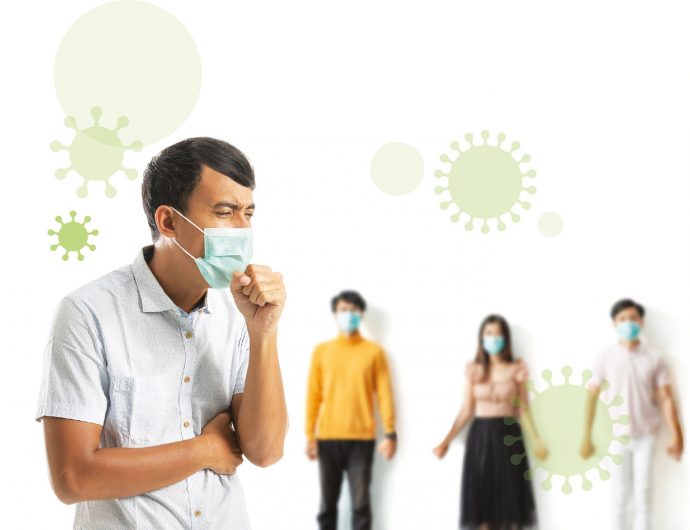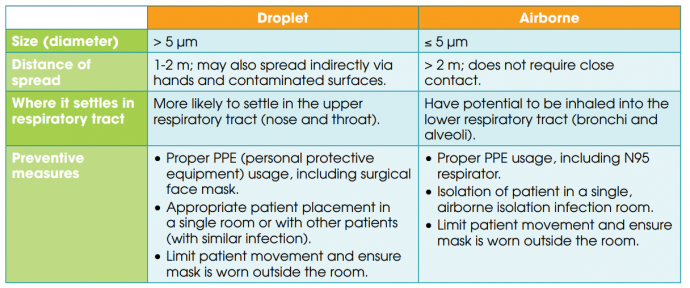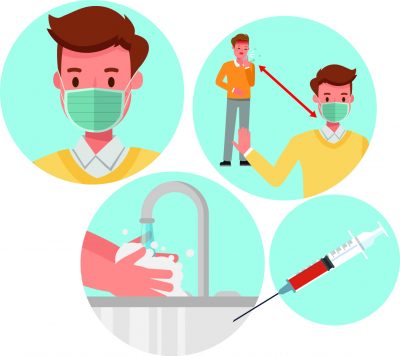During the COVID-19 pandemic, we were told how the disease spreads by respiratory droplet transmission, particularly by coughing and sneezing. Many other diseases, such as flu, also spread this way. How can we mitigate this type of transmission?
Pathogens such as viruses, bacteria, fungi and parasites are responsible for many infectious diseases. One way to categorise infectious diseases is by how they spread. These diseases can transmit directly or indirectly from the reservoir of the pathogen (which can be an organism or the environment) to humans.
Common transmission routes
- Respiratory droplet
- Airborne
- Faecal-oral
- Sexual
- Vector-borne
- Blood
- Contaminated surface
- Contaminated food and water
- Animal-to-person
- Mother-to-child
Respiratory droplet transmission
Viruses such as influenza virus, rhinovirus, respiratory syncytial virus (RSV) and coronavirus spread via respiratory droplet transmission. A respiratory droplet is a particle consisting mostly of water, as well as various cells, physiological electrolytes and possibly infectious agents. It has a diameter greater than 5 micrometre (μm; 1000μm= 1mm) (for reference, the diameter of a strand of Asian hair is 80-120μm). These droplets tend to rapidly fall to the ground due to gravity, hence limiting spread to within a short distance.
The droplets are produced naturally when we sneeze, cough, talk, sing or breathe. They may also form artificially during medical procedures such as cardiopulmonary resuscitation (CPR), intubation, bronchoscopy and surgery. Transmission occurs when the droplets reach vulnerable mucosal surfaces (eyes, nose or mouth).
Sneezes and coughs are the main routes of transmission. A sneeze can produce up to 40,000 droplets, while coughing can produce up to 3000 droplets. This is about the same as talking for five minutes!
Droplet vs airborne transmission
Factors of spread & survivability
The content of droplets depends on their origin in the respiratory tract. The formation and distribution of the droplets are determined by factors such as the velocity of exhaled air, viscosity, content and quantity of fluid, and flow path (i.e. through the nose, mouth or both). The direction and strength of airflows, temperature, humidity and other environmental factors also play important roles.
Indirect transmission may occur via contact with contaminated objects or surfaces. Viruses generally survive longer on hard surfaces than porous surfaces. Moreover, viruses protected by a lipid layer (e.g. influenza virus, RSV and coronavirus), are more stable under dry conditions, whereas viruses without protective layer (e.g. rhinovirus, enterovirus and adenovirus) are more stable under humid conditions. Viruses are also more stable at low air temperatures.
Preventing droplet transmission
- Cough/sneeze etiquette. Cover your mouth with a tissue or your elbow when coughing or sneezing, dispose of the tissue properly, and wash your hands immediately. Stay home if possible, but wear a face mask if you need to go out.
- Social (or physical) distancing. This depends on the scale of the outbreak. If it is an epidemic, you may need to avoid crowded places, keep 1-2 m away from others in public spaces and avoid physical greetings (e.g. handshaking or hugs). Staying at home is the simplest way!
- Practise hygiene. Wash your hands with soap frequently and thoroughly, especially before and after preparing or eating food, and after using the toilet. Hand sanitisers can also be used. Avoid touching your eyes, nose and mouth. Sanitise commonly used objects/surfaces.
- Vaccination. Some infectious diseases can be prevented with vaccination. For example, it is recommended to take flu vaccines annually as there are different flu viruses circulating for every flu season and immunisation declines over time. The development of COVID-19 vaccine is still on-going.
The COVID-19 health crisis has been a very solemn experience for all of us. Hundreds of thousands of deaths have been recorded and millions have been infected worldwide. As we move forward, we need to continue practising the new norms, like frequent handwashing and cough/sneeze etiquette, to prevent future outbreaks as well as the spread of other illnesses.
An educational contribution by Malaysian Paediatric Association.








Comments